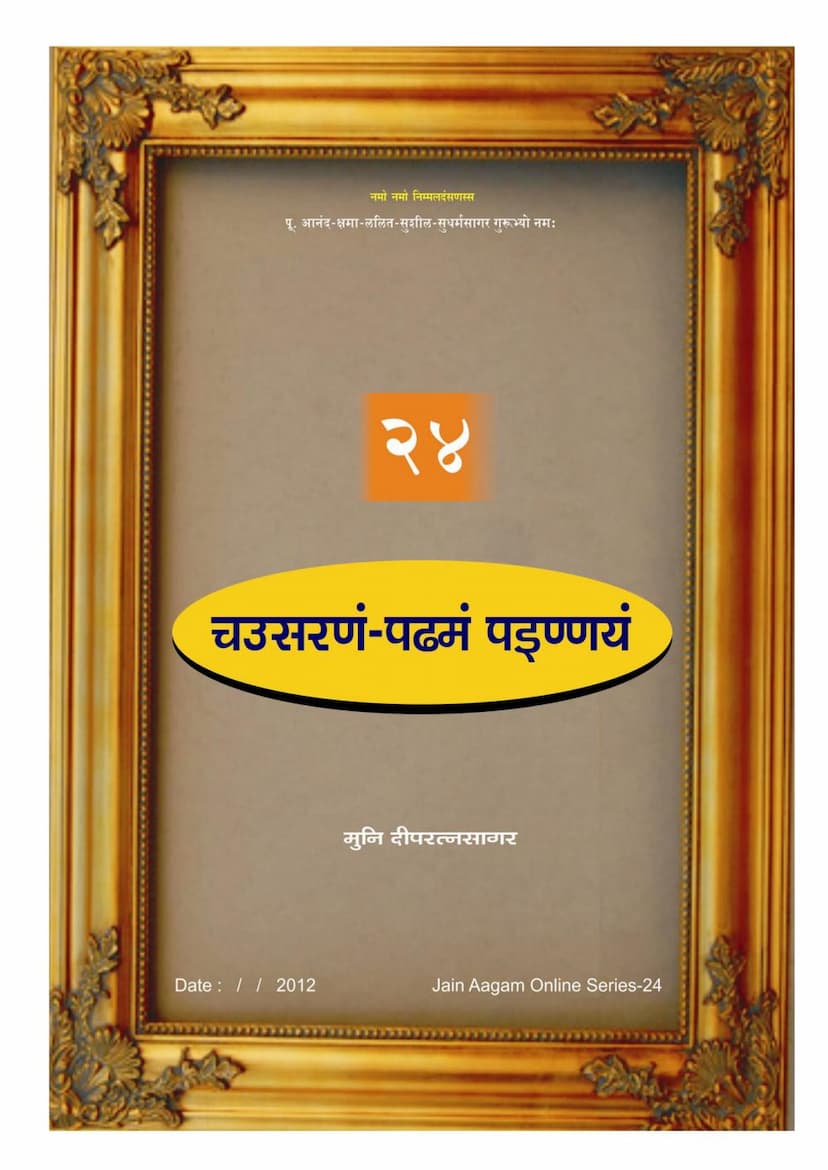Agam 24 Chausaranam Padhamam Painnayam Mulam PDF File
Added to library: September 1, 2025

Summary
Here's a comprehensive summary of the provided Jain text, "Agam 24 Chausaranam Padhamam Painnayam Mulam," in English:
Book Title: Agam 24 Chausaranam Padhamam Painnayam Mulam Author(s): Dipratnasagar, Deepratnasagar Publisher: Deepratnasagar Jain Aagam Online Series-24
This text, titled "Chausaranam Padhamam Painnayam Mulam" (The First Ancillary Text on Fourfold Refuge), is part of the Jain Aagam Online Series. It is presented as a collection of verses (Gaha) and focuses on the concept of taking refuge in the Four Jewels of Jainism, followed by reflections on repentance and the merits of good deeds.
Core Content and Structure:
The text is structured around the concept of Chausaranam, which translates to "Fourfold Refuge." This is a central tenet in Jainism, referring to taking refuge in:
- Arhanta: The liberated souls who have achieved perfection and are the first Jinas (victorious ones).
- Siddha: The souls who have attained eternal liberation and are beyond birth and death.
- Sahu (Sadhu/Monk): The spiritual preceptors and ascetics who follow the path of righteousness.
- Dharma: The true nature of reality, the path of liberation as taught by the Jinas, characterized by non-violence, truthfulness, non-stealing, chastity, and non-possession.
Key Sections and Themes:
-
Introduction and Purpose (Pages 1-2):
- The text begins with salutations (Namah) to purity of vision (Nimmaldansanassa) and spiritual guides.
- It lists the "Gantha'nukkamo" (index of verses) which outlines the subjects covered: Mangala-aadi (auspicious beginning), Chatusarana (Fourfold Refuge), Dukkhadagariha (repentance for misdeeds), Sukka (good deeds/merits), and Upsanhar (conclusion).
- The introductory verses emphasize the importance of the Fourfold Refuge for overcoming the cycle of birth and death (chaugai-harana).
-
The Concept of Fourfold Refuge (Chausaranam) (Pages 3-5):
- The majority of the text (from Gaha 11 onwards) elaborates on taking refuge in each of the Four Jewels.
- Refuge in Arhanta: Verses describe the qualities of Arhantas, their victory over passions (ragadvosa), their attainment of omniscience and liberation from worldly ties. They are praised as the destroyers of suffering and the guides to the path of salvation. Specific verses highlight Arhantas who have achieved Kevala Jnana (omniscience), are adorned with immense virtues, and are worshipped by gods and kings.
- Refuge in Siddha: The text extols the Siddhas as souls who have conquered birth, death, and all sorrows. They are described as the source of well-being for the three worlds, possessing infinite knowledge and power. Verses detail their perfect state, their detachment from worldly concerns, and their ultimate liberation.
- Refuge in Sahu (Monks): The verses praise the virtues of monks, their adherence to vows, their detachment from worldly pleasures, their compassion, and their dedication to spiritual practice. They are described as the upholders of the Jain tradition, those who have conquered their senses and passions. The text mentions different categories of monks and their exemplary conduct.
- Refuge in Dharma: The true Dharma is depicted as the path to liberation, characterized by non-violence, truth, purity, and detachment. It is the means to overcome karmic obstacles and attain the highest bliss. The verses emphasize the all-encompassing nature of Dharma, its ability to grant ultimate happiness, and its power to destroy negative karma.
-
Repentance (Dukkhadagariha) (Pages 5-6):
- Following the praise of the Four Jewels, the text shifts to the importance of Dukkhadagariha, which signifies repentance or confession of sins.
- Verses express regret for past wrongdoings, including errors stemming from ignorance, disrespect towards the Jinas and the Jain tradition, and harm caused to other beings. The repentance is deep and sincere, acknowledging all forms of transgressions committed through mind, speech, and body.
-
Appreciation of Good Deeds (Sukka) (Page 6):
- The text then moves to Sukka, the appreciation and endorsement of good deeds.
- It emphasizes the importance of acknowledging and approving the virtuous actions of Arhantas, Siddhas, Acharyas (preceptors), Upadhyayas (teachers), monks, and even lay followers. This endorsement of good deeds is seen as a way to cultivate merit and reinforce positive spiritual progress.
- The verses highlight the joy and satisfaction derived from righteous actions and the ultimate goal of achieving liberation through them.
-
Conclusion (Upsanhar) (Page 6):
- The concluding verses summarize the benefits of following the Fourfold Refuge. It states that by adhering to this path, one cultivates auspicious qualities and attains enduring happiness.
- The text ends with a reflection on the preciousness of this human birth and the opportunity it provides for spiritual advancement. It stresses the importance of constant remembrance and meditation on the Four Jewels as the means to attain Nirvana (cessation of suffering).
Overall Significance:
"Agam 24 Chausaranam Padhamam Painnayam Mulam" is a devotional and didactic text that serves as a guide for Jains seeking spiritual purification and liberation. It reiterates the fundamental principles of taking refuge in the Three Jewels (Arhanta, Siddha, and Sadhu) and the Dharma itself. The text emphasizes the importance of a holistic approach to spiritual practice, which includes not only devotion and contemplation but also sincere repentance for past mistakes and the enthusiastic appreciation of good deeds performed by oneself and others. The meticulously composed verses aim to inspire faith, guide practice, and ultimately lead the aspirant towards the ultimate goal of Moksha (liberation).